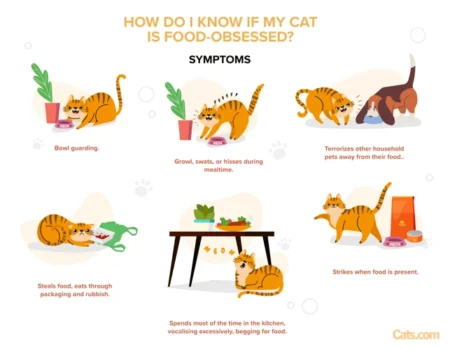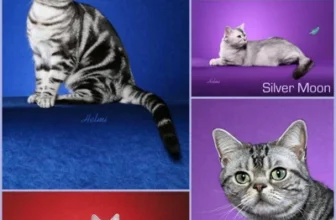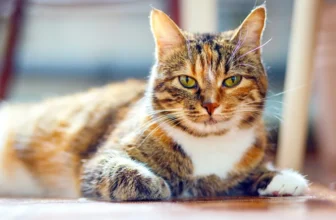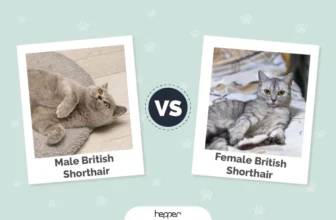Have you ever experienced your American Shorthair constantly meowing and begging for food? As a cat owner, it can be daunting to resist those adorable and persistent purrs. However, it’s important to remember that constantly feeding your cat can lead to obesity and digestive issues. To prevent your cat from constantly begging for food, it’s important to understand the root causes of their behavior and implement effective strategies to break this cycle. In this article, we’ll discuss how to prevent your American Shorthair from begging for food through various techniques such as diet, training and playtime. So, let’s dive into the world of cat behavior and learn how to keep them healthy and happy.
Understanding Why American Shorthairs Beg for Food
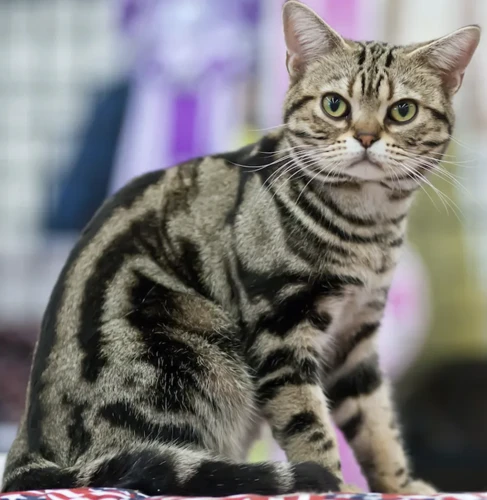
Understanding your cat’s behavior is important to prevent bad habits such as begging for food. American Shorthairs are intelligent and curious cats that are quite unique and complex in their behavior. They have different ways of communicating with their owners and are extremely good at training their owners to do what they want. American Shorthairs are prone to begging for food, and it can be challenging to resist those adorable and convincing eyes looking up at you. In this article, we will examine why American Shorthairs beg for food, and provide you with some practical tips to prevent this behavior. To learn more about how to train your American Shorthair for playtime, click here.
Understanding Your Cat’s Behaviour
Understanding your cat’s behavior is important in preventing your American Shorthair from begging for food. Cats may beg for food for various reasons, such as boredom, anxiety, or simply because they have developed a bad habit.
One of the common reasons why cats beg for food is because they are bored. Cats that are left alone for long periods of time can become bored and may resort to begging for food as a form of entertainment. Providing your cat with toys that keep them engaged and active, such as interactive toys or puzzle feeders, can help prevent boredom and reduce the likelihood of begging for food.
Another reason why cats beg for food is anxiety. Some cats may become anxious when their owners leave the house, which can lead to begging for food upon their return. If your cat shows signs of anxiety, such as hiding, excessive grooming, or destructive behavior, you may need to address this issue before tackling their begging behavior. Providing your cat with a comfortable and secure environment, as well as regular playtime and interaction with you, can help reduce anxiety and prevent begging for food.
Additionally, cats may beg for food simply because they have developed a bad habit. If you have reinforced this behavior in the past by occasionally giving your cat a treat or feeding them from the table, they may have learned that begging for food is an effective way to get what they want. It is important to avoid reinforcing this behavior in the future and provide your American Shorthair with a consistent feeding schedule instead.
Important note: If your American Shorthair is also exhibiting unwanted behaviors such as scratching furniture, jumping on counters, or meowing excessively, these issues should be addressed in conjunction with their begging behavior. Check out these relevant articles for tips on how to address these issues: stop American Shorthair from scratching furniture, stop American Shorthair from jumping on counters, stop American Shorthair from meowing excessively, train American Shorthair for playtime, and eliminate American Shorthair’s night crazies.
Avoiding Reinforcing Bad Habits
When it comes to preventing your American Shorthair from begging for food, it is important to avoid reinforcing bad habits that may have already formed. Reinforcing bad habits can make it more difficult to change your cat’s behavior in the long run.
For instance, if you often give in to your cat’s demands for food, then they may learn that begging is an effective way to get what they want. This can lead to your cat becoming persistently demanding and vocal around meal times. To avoid this, it is essential that you establish clear boundaries and stick to them. You can do this by setting designated feeding times and following a consistent feeding schedule.
Another bad habit to avoid is feeding your cat human food, particularly food from the table. While it can be tempting to give your cat scraps, this can also encourage begging behaviors. Instead, feed your cat a high-quality diet that is appropriate for their nutritional needs.
Finally, it is important to be aware of your own behavior around your cat. Some cat owners may inadvertently reinforce bad habits by giving their cat attention or a reward when they beg for food. This can be as simple as giving your cat attention when they meow or beg for food. To break this habit, try to remain neutral and avoid giving your cat any attention during meal times. Redirecting their attention to a toy can also be helpful.
Avoiding reinforcing bad habits is essential if you want to prevent your American Shorthair from begging for food. Taking the time to establish good habits early on can help to ensure that your cat is well-behaved and happy. If you struggle with other behavior issues with your cat, like marking indoors, check our tips for discouraging American Shorthair marking indoors.
Setting Meal Times and Quantity
Setting meal times and quantity is essential in preventing your American Shorthair from begging for food. It is important to establish a feeding routine and stick to it. This not only helps your cat feel secure and comfortable, but it also prevents overeating and begging for food outside of their meal times.
Here are some tips for setting meal times and quantity:
| Tip | Description |
|---|---|
| 1. Determine the Amount of Food to Feed Your Cat Daily | Check the label of your cat’s food package for recommended feeding amounts based on weight and age. Divide the total amount by the number of meals you plan to feed your cat. This will give you the correct portion size per meal. |
| 2. Use a Measuring Cup | Using a measuring cup ensures that you are giving your cat the correct portion size. It also helps you keep track of how much your cat is eating and prevents overfeeding. |
| 3. Feed Your Cat at Regular Times | Establish set meal times and stick to them as closely as possible. This routine will help your cat know when it’s time to eat and when it’s not. It will also prevent your cat from begging for food throughout the day. |
| 4. Avoid Free-Feeding | Free-feeding is when you leave food out all day for your cat to eat whenever they want. This often leads to overeating and obesity. Instead, feed your cat at set times and pick up any uneaten food after 30 minutes. This will help your cat learn to eat when it’s mealtime. |
| 5. Avoid Feeding Your Cat Before Bedtime | Feeding your cat right before bedtime can disrupt their sleeping patterns and make them more likely to beg for food in the morning. Try to feed your cat at least 2 hours before bedtime to avoid any unwanted behavior. |
By setting meal times and quantity, you can prevent your American Shorthair from begging for food outside of their set meal times. This will lead to a healthier and happier cat in the long run. Remember to establish a routine and be consistent with feeding times and portion sizes.
5 Effective Ways to Prevent Your American Shorthair from Begging for Food
As a responsible pet owner, preventing your American Shorthair from begging for food is crucial for their health and overall well-being. While it can be difficult to resist those big, pleading eyes, it’s important to establish boundaries and good habits early on. In this section, we’ll discuss some effective techniques for curbing your cat’s begging behavior and ensuring they maintain a healthy diet. Let’s take a closer look.
1. Feed Your Cat High-Quality Diet
Feeding your American Shorthair a high-quality diet is one of the most effective ways to prevent them from begging for food. When it comes to choosing the right food for your furry friend, it’s important to choose a well-balanced diet that contains all the essential nutrients that your cat needs.
The following are some guidelines to help you choose the right high-quality diet for your cat:
- Choose a diet with high-quality protein: American Shorthairs are carnivores, which means that they require a diet high in protein. Choose a diet that has meat listed as the first ingredient.
- Avoid low-quality fillers: Some low-quality cat foods contain fillers such as wheat and corn. These fillers can cause your cat to feel hungry soon after eating and may lead to excessive begging for food.
- Read the labels: The labels on your cat’s food can give you important information about the content of the food. Look for a food that contains a balance of essential nutrients, including protein, fats, and carbohydrates.
- Consult your veterinarian: Your veterinarian can provide you with valuable recommendations on the best diet for your cat. Different cats have different dietary requirements depending on factors such as age, weight, and health conditions. Consulting with your veterinarian can help you make an informed decision on the best food for your cat.
By providing your American Shorthair with a high-quality diet, you can improve their overall health and reduce the likelihood of excessive begging for food. However, keep in mind that it’s important to transition your cat to a new diet gradually to avoid digestive issues.
2. Use Treats Responsibly
Giving treats can be a way to show love and affection to your American Shorthair cat. However, it is important to use treats responsibly to prevent your cat from developing a habit of begging for food. Here are some tips on how to use treats responsibly:
- Limit the quantity: Treats should only make up a small portion of your cat’s total diet. It is recommended to give no more than 10% of your cat’s daily calorie intake as treats. Overfeeding treats can lead to obesity and other health issues.
- Choose healthy treats: When choosing treats for your cat, opt for healthy options that are low in fat and calories. Some good options include freeze-dried meat or fish treats, catnip, or small pieces of cooked chicken or turkey.
- Avoid table scraps: While it may be tempting to share human food with your cat, it is best to avoid feeding table scraps altogether. Table scraps are often high in salt, fat, and other unhealthy ingredients that can cause health problems and create bad habits in your cat.
- Use treats for training: Treats can be a useful tool for training your cat to obey commands or engage in positive behavior. However, it is important to only offer treats as a reward, and not as a bribe to stop bad behavior.
By using treats responsibly, you can help ensure that your American Shorthair cat stays healthy and doesn’t develop a habit of begging for food. Remember to always consult with your veterinarian about the best diet for your cat’s specific needs.
3. Train Your Cat Not to Beg
Training your American Shorthair not to beg for food is an effective way to prevent this bad habit. The first step is to establish a clear command, such as “no begging.” You should use a confident and firm voice when giving this command.
Here are some tips to help train your cat:
- Consistency is key: Make sure everyone in the household uses the same command and reinforces the same behavior consistently.
- Positive reinforcement: Reward your cat for good behavior with treats, toys, or affection. This will encourage them to continue behaving well.
- Ignore bad behavior: When your cat begs for food, do not give them any attention. This will teach them that begging will not get them what they want.
- Teach alternative behaviors: Provide your cat with an alternative activity when they beg for food, such as playing with a toy or getting some exercise. This will help distract and redirect their attention.
- Patient training: Remember that training your cat may take time and patience. Consistent reinforcement and patience will go a long way in stopping the unwanted behavior of begging for food.
By following these training tips, you can teach your American Shorthair that begging for food is not a desirable behavior. Instead, they will learn to wait patiently for their designated mealtimes and seek attention and treats in appropriate ways.
4. Keep Your Cat Busy with Toys
As we know, American Shorthairs love to spend their time lounging around the house. To keep them entertained and distract them from food, providing them with toys is a great way to keep them busy. Here are some toy options you can consider:
- Puzzle Feeders: Puzzle feeders can keep your cat entertained, and at the same time, provide treats as a reward once solved. These toys come in different shapes and sizes and can be a great source of entertainment for cats who enjoy a challenge.
- Laser Pointers: Laser pointers are also an excellent toy option to keep your cat busy. However, they should only be used under supervision, since they can cause some behavioral problems when used excessively.
- Catnip Toys: Catnip is a plant that releases a chemical that cats love. When your American Shorthair chews on a catnip toy, it stimulates their mind and can be a great way to distract them from food.
- Feather Wands: Feather wands are also an excellent toy option for your American Shorthair. These toys mimic the natural movements of birds and can trigger your cat’s hunting instincts, making them more active and engaged with the toy.
It is essential to keep in mind that cats are creatures of habit and prefer specific toys. If you notice that your American Shorthair isn’t interested in a toy, it doesn’t mean they don’t like to play. It just means that particular toy may not be to their liking. Try to experiment with different toys and observe which ones your cat loves the most.
5. Avoid Feeding Your Cat From the Table
Feeding your American Shorthair from the table can be a tempting way to share your meal with your beloved pet, but it can also lead to begging. It’s important to set boundaries and train your cat to understand that table food is not for them. Here are a few ways to avoid feeding your cat from the table:
| Method | Explanation |
|---|---|
| 1. Feed your cat before you eat | If your cat is fed and satisfied before you sit down to eat, they will be less likely to beg for your food. Plus, this will help avoid making your cat obese. |
| 2. Keep your cat out of eating areas | It’s important to establish boundaries for your cat and keep them away from eating areas. This can be done by closing doors or investing in baby gates to keep them out of the dining room. |
| 3. Use a distracting toy | While you eat, keep your cat entertained and distracted with a toy. This will help them focus on something other than your plate of food. |
| 4. Ignore your cat’s begging behavior | One of the best ways to prevent your cat from begging is to ignore their behavior. Do not give in and do not reward them with food from the table. Eventually, they will learn that begging does not lead to food. |
Avoiding feeding your cat from the table may take some training and patience, but it’s an important step to keep your cat healthy and prevent bad habits. Remember to stay consistent in your training and set clear boundaries for your American Shorthair.
Conclusion
After implementing the above-mentioned ways to prevent your American Shorthair from begging for food, you’ll notice a positive change in their behavior and overall health. Remember that feeding your feline friend a balanced diet, setting meal times, and keeping them busy with toys can all play a significant role in curbing their begging behavior.
It’s crucial to avoid reinforcing bad habits and using treats responsibly to maintain your cat’s weight and health. Training them not to beg may take some time and patience, but the rewards are well worth it. Additionally, avoiding feeding your cat from the table is an effective way to break the habit of begging.
By adhering to these preventive measures, you not only care for your American Shorthair’s well-being but also ensure that their eating habits do not become problematic. Proper nutrition and feeding management can help your cat to live a long and healthy life.
Remember to consult with your veterinarian to determine the best diet and feeding routine for your cat, especially if your cat has any special dietary needs or health concerns. With consistent practice and adherence to these preventive measures, your American Shorthair will be on the road to a healthier and happier life.
Frequently Asked Questions
1. Why do cats beg for food?
Cats may beg for food due to boredom, anxiety, or simply because they enjoy the taste of human food. Providing a high-quality diet and setting meal times can prevent this behavior.
2. Is it bad to give cats human food?
Giving cats human food can lead to obesity, digestive problems, and other health issues. It’s best to stick to a high-quality cat food diet and use treats sparingly.
3. How often should I feed my American Shorthair?
Adult American Shorthairs should be fed two meals per day. Follow the feeding guidelines on the cat food packaging and adjust according to your cat’s weight and activity level.
4. Can toys help stop my cat from begging for food?
Yes, toys and playtime can help keep your cat mentally stimulated and distracted from begging for food. Provide a variety of toys, including interactive ones that require your cat to work for treats.
5. Will training my cat to not beg for food be difficult?
Training your cat to not beg for food may take time and patience, but it is doable. Consistency and positive reinforcement are key. Treats should only be given as a reward for desired behavior.
6. How can I tell if my American Shorthair is overweight?
You can tell if your cat is overweight by feeling their ribcage – you should be able to feel the ribs without having to press down too hard. Additionally, a noticeable belly bulge is a sign of excess weight.
7. Should I free-feed my American Shorthair?
No, free-feeding can lead to overeating and obesity in cats. It’s best to stick to scheduled meal times and portion sizes.
8. Can a high-quality diet help with begging behavior?
Yes, feeding your cat a high-quality diet that is rich in protein can help keep them satisfied for longer periods of time, reducing the likelihood of begging behavior.
9. Do I need to consult with a veterinarian for advice on my cat’s diet?
Yes, it’s always best to consult with a veterinarian regarding your cat’s diet and nutritional needs. They can provide guidance on portion sizes, feeding frequency, and appropriate food choices.
10. Is it okay to give my cat milk?
No, most cats are lactose intolerant and feeding them milk can lead to digestive problems and diarrhea. Stick to providing fresh water for your cat to drink.

